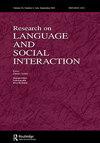Responding to In-the-Moment Distress in Emotion-Focused Therapy
IF 2.1
1区 文学
Q1 COMMUNICATION
引用次数: 3
Abstract
ABSTRACT Emotion-focused therapy offers a setting in which clients report on their personal experiences, some of which involve intense moments of distress. This article examines video-recorded interactional sequences of client distress displays and therapist responses. Two main findings extend understanding of embodied actions clients display as both a collection of distress features and as interactional resources therapists draw upon to facilitate therapeutic intervention. First, clients drew from a number of vocal and nonvocal resources that tend to cluster on a continuum of lower or higher intensities of upset displays. Second, we identified three therapist response types that oriented explicitly to clients’ in-the-moment distress: noticings, emotional immediacy questions, and modulating directives. The first two action types draw attention to or topicalize the client’s emotional display; the third type, by contrast, had a regulatory function, either sustaining or abating the intensity of the upset. Data are in North American English.以情绪为中心的治疗应对当下的痛苦
摘要以情绪为中心的治疗提供了一种环境,客户可以在其中报告他们的个人经历,其中一些经历涉及强烈的痛苦时刻。本文研究了视频记录的客户痛苦表现和治疗师反应的互动序列。两个主要发现扩展了对客户表现为痛苦特征集合和治疗师为促进治疗干预而利用的互动资源的具体行动的理解。首先,客户从许多声音和非声音资源中提取,这些资源往往集中在较低或较高强度的不安显示的连续体上。其次,我们确定了三种明确针对客户当下痛苦的治疗师反应类型:通知、情绪即时性问题和调节指令。前两种动作类型会引起人们对客户情绪表现的关注或将其主题化;相比之下,第三种类型具有调节功能,可以维持或减轻沮丧的强度。数据采用北美英语。
本文章由计算机程序翻译,如有差异,请以英文原文为准。
求助全文
约1分钟内获得全文
求助全文
来源期刊
CiteScore
7.30
自引率
7.40%
发文量
20
期刊介绍:
The journal publishes the highest quality empirical and theoretical research bearing on language as it is used in interaction. Researchers in communication, discourse analysis, conversation analysis, linguistic anthropology and ethnography are likely to be the most active contributors, but we welcome submission of articles from the broad range of interaction researchers. Published papers will normally involve the close analysis of naturally-occurring interaction. The journal is also open to theoretical essays, and to quantitative studies where these are tied closely to the results of naturalistic observation.

 求助内容:
求助内容: 应助结果提醒方式:
应助结果提醒方式:


